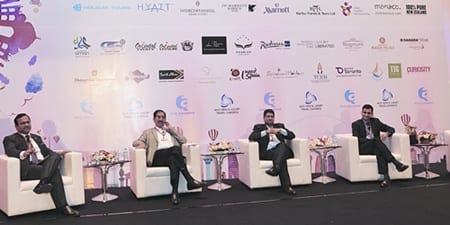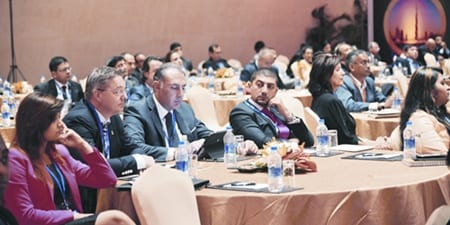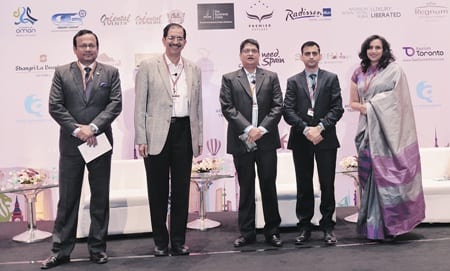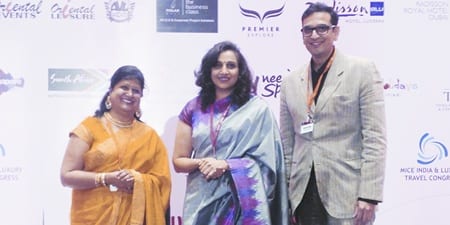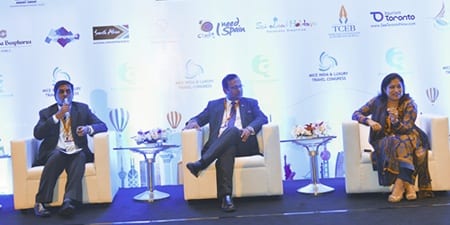Meeting at MILT
Focusing on the corporate and film tourism segments, the third annual MILT Congress unearthed some of the challenges and success stories of key decision makers. By Akshay Kumar
With a focus to provide the Indian corporate buyers and international travel and hospitality suppliers the opportunity to create lasting partnerships and to streamline MICE activities, Dubai based QnA International recently organised the third annual MICE India and Luxury Travel (MILT) Congress in Mumbai from July 30 to 31, 2015.
The main focus of the congress was to target the corporate sector and to understand its key decision makers and their challenges, and also to open up new avenues for MICE travellers. A panel discussion was hosted to understand the industry best practices, incentive travel and gaining ROI from incentive travel. The panelists who participated were Akshay Mehrotra, chief executive officer, Big Bazaar; Alok Saraogi, vice president – brand management and corporate communications, Ashok Leyland; Sudhakar Pai, chairman and MD, Kurlon and Sujan Roy, head of marketing (international), Tata Motors.
Speaking about the success story behind Kurlon’s MICE activities, Pai stated, “Kurlon is the first company in India to take dealers abroad for incentives. As of now, we have more than 10,000 dealers, this is because of the Kurlon Care Club which we had started 12 years ago to build our relationship with dealers. This MICE programme particularly has helped us a lot to grow in India. Today, every dealer feels that he should be a part of our club.”
Along with increase in incentive tours, many challenges have emerged over the years. Sarogi opined, “Today, one of the major challenges, is that as we take more people across the world for incentive travel, the option of destinations are decreasing. We need the tour operators’ support to come up with new destinations which will create an interest in our dealers. Value perception is a major aspect in such incentives and we want to maximise the value. Today, people want to go for experiential tours rather than just visit a destination.” Mehrotra added, “We always take a large number of delegates, many of whom are first timers. Sometimes we have witnessed that some people disappear, we must ensure that there is a system to track such crowd. One of the major challenges for an organiser is to make an itinerary, which allows the delegates to enjoy every aspect of the location.”
One of the key aspects for any incentive travel is budget management. This in fact is a key deciding factor for corporates who organise such tours. Speaking about budget management, Roy stated, “Any destination which is at a flying distance of six hours from India is the best available option for us budget-wise and irritability-wise. Also, today delegates are not interested in visiting countries like Dubai and Thailand for a vanilla package. We need to explore at least 10 new destinations, where connectivity should be good and which will fit into our budget.”
Consul encounter
With facilities like e-visa and visa-on-arrival, travel has become a lot more easier. This also plays a role in the destination selection process. Corporates prefer destinations where the visa procedure is not a hassle. Mehrotra mentioned, “Destinations like the UK becomes an headache for us when it comes for a group visa. If we take our suppliers and sales team, a lot of them don’t have a very strong paper work. Some of the consulates do not help in such situations.”
With more joint visa schemes coming up, a lot more destinations are opening up for MICE travellers. Roy explained, “Some countries do smart group visas, which are extremely beneficial for MICE groups. For example, destinations like Macao and Guangzhou are very favourable for MICE as they help in joint visa. Some emerging destinations like Oman can also create new opportunities.” Pai added, “One of the most important factors is the e-visa facilitation. Once we were taking a large group to Singapore, and one family in our group was from a small village. This family was denied a visa, immediately we changed our destination and went to Thailand. I think the perception of the consulates must change a lot, as India is a market where many people have started travelling.”
The event also witnessed a keynote presentation on the use of marketing to ensure a sustainable, profitable business by Ruchi Aggarwal, director- partner strategy and marketing, Microsoft. The presentation was based on how to market personal and business brand and how to leverage the power of digital marketing.
Target 35mm
Cinemas have been very crucial in promoting a destination. Movies like ‘Zindagi Na Milegi Dobara’, have sent troops of movie buffs to Spain. Some destinations provide incentives for film production, which is again a location deciding factor. Speaking about the practices of Yash Raj Films, Aashish Singh, VP production, Yash Raj Films stated, “We are a very creatively driven company where the script decides our destination. But, whenever we shoot abroad, budget is the most important factor. In such a situation we look out for incentives. I think tourism follows shooting of a movie. After the success of ‘Braveheart’, the castles of Scotland saw an increase of 40 per cent in tourism footfall. So destinations must provide incentives for film production.”
Mala Manyan, executive producer, Madras Talkies, pointed out, “Even a 30 second song shot in a destination is often remembered by the viewers. Shooting a movie promotes a destination in a strong way, so claiming incentives is extremely fair. South Indian cinemas are a tough competition to Bollywood, even we shoot a lot of movies and song sequence abroad. Also, single window clearance is very important. The consulate, tourism board and the tour operator must be on the same page.”


